#most notably Claire Keane
Text
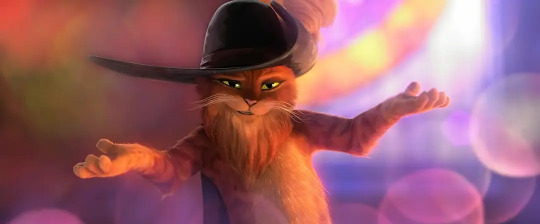
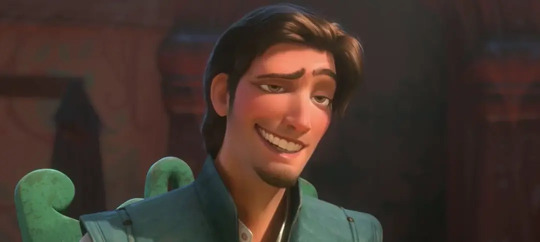
They do share certain similarities, correct?
#nobody has mentioned this before so I might just as well point it out#it's not just me thinking about this right?#trivia: some of the animators from Tangled do work on Puss in Boots: the Last Wish#most notably Claire Keane#Coincidence?#puss in boots: the last wish#pibtlw#puss in boots 2 spoilers
17 notes
·
View notes
Photo
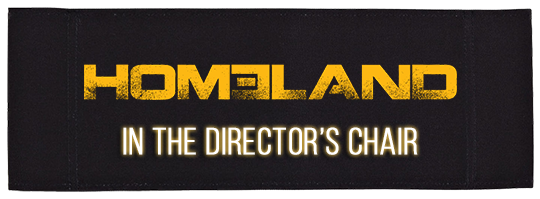
“False Friends” | Directed by Keith Gordon, Cinematography by Peter Levy

In case you hadn’t heard, Carrie smoked a few cigarettes this week. The opening of the episode is actually pretty interesting, the conversation with Yevgeny the previous night in the bar ringing in Carrie’s ears. (Carrie isn’t sleeping--again--and we all know that spells trouble for her.)
Carrie is, for the most part, a loner smoker. And a stress smoker. And a rooftop smoker, apparently! Here more than in previous instances where we’ve seen her smoke, the setting--all alone on the roof--visually represents her own headspace.
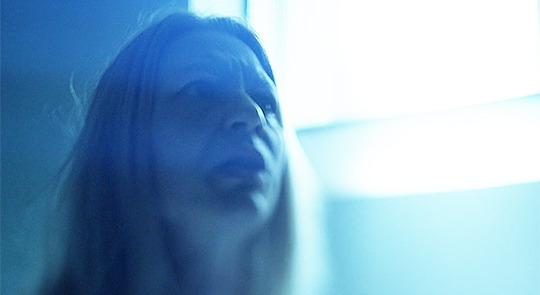
She flashes back to the scene we’ve seen several times already this season. This time, however, we finally see Carrie clearly. She speaks, she’s lucid. There is real fear in her expression, but also longing. The reveal of course is that Carrie is on her meds and in her right mind, and she doesn’t want Yevgeny to leave.

The camera turns to Yevgeny as Carrie’s dragged away. This is a shot we’ve seen already this season but, by the end of the episode, his expression takes on a different meaning. It’s not cold or detached. He doesn’t want to leave her either.
The repetition of this specific memory and the way it’s morphed over the episodes is remarkably similar to early season one Brody. We all knew the Carrie/Brody parallels this season would be heavy; the show is not only retelling that story with roles reversed but also using many of the storytelling devices they used in season one.
Then as now, the audience learns along with the characters what actually took place. First we learn that Brody actually did know Nazir; Nazir held him. Then we learn that Brody watched Tom Walker die. Then we learn that Brody is the one who beat Tom Walker to death (or at least he thought he did). The key difference obviously is that Brody was deceiving Carrie. Carrie is deceiving herself (or is she?).
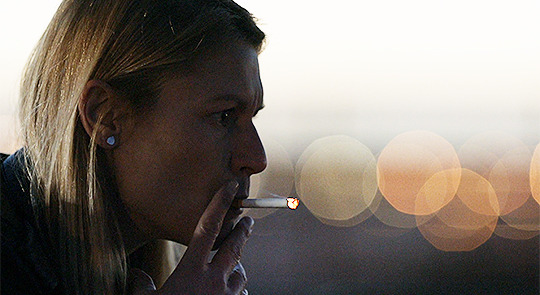
IJLTP. (Any time this show does something with bokeh IJLTP.) (Bokeh is the way a camera lens renders out-of-focus points of light.)
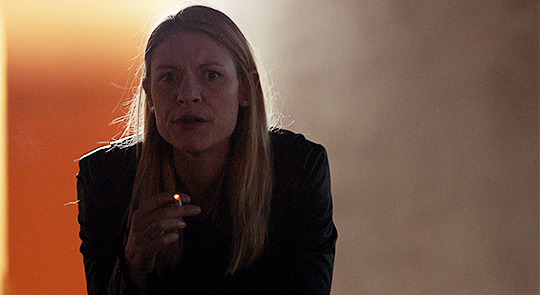
We thought the framing of this particular shot was interesting. There are two blocks of color behind Carrie, orange and white, and her body lies squarely in the center of either, one half on either side. Maybe this was completely accidental, or maybe it’s symbolic and indicative of the way she’s being pulled in different directions. She also remains in the dark--figuratively and literally. In the first episode of the season, Carrie was often framed inside rectangular boundaries, now she’s half-in, half-out. Before, she felt trapped in the car, in her bedroom, in the fenced-in basketball court. Now, she finally gets some freedom (and maybe a dollop of “fresh” air, natch).
(There is a similar Mad Men shot that Sara thinks about at least weekly that conveyed something similar about Don.)
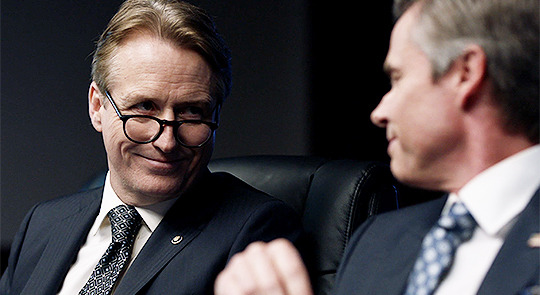
Linus Roache’s performance as David Wellington is fairly underrated. It’ll be interesting to see him in a context other than “Elizabeth Keane’s mouthpiece/bodyguard/sounding board/good cop/bad cop.” For example, this passive aggressive grin at new VP Ben Hayes when he makes a similarly passive aggressive comment about Princeton.

...or this side eye when Ben Hayes suggests firing Saul, a “Keane holdover.”
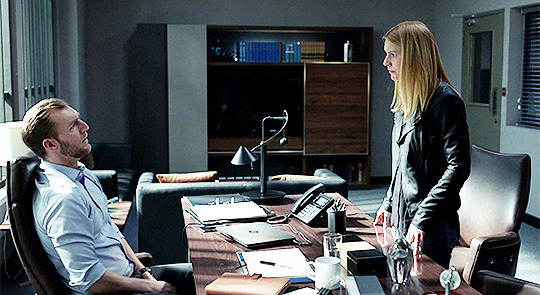
Carrie’s comment in the premiere that Mike was not an “alpha” looms large in this scene and throughout the episode. Carrie makes several comments about him finally doing the job the right way or her way. Their differing personalities and management styles are on full display visually here. Carrie towers over him, while Mike sits back, hands folded in his lap.
Also, as a logistics person, it bothers Gail that Mike has set up his desk so his back is facing the window. With all of that top secret intel on his computer, isn’t having the windows right there a problem? Is this an intentional nod to his incompetence or did the better lighting of his office for the crew win out? (Sara thinks it can be both.)
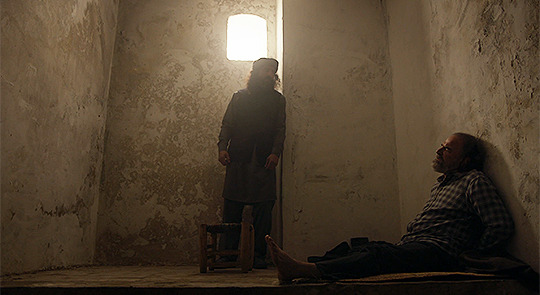
The Saul/Haqqani scenes this episode were uniformly visually stunning. First, the show continues its use of light to reinforce who knows what. Here Haqqani’s face is cloaked in darkness while light falls across Saul’s face.
Overall, Saul’s captivity plays out plot-wise obviously much differently this time than in season four. We’re struck as well by how different the mood is. Both men lean or hunch here. They’re tired, they’re old, they’ve done this before.
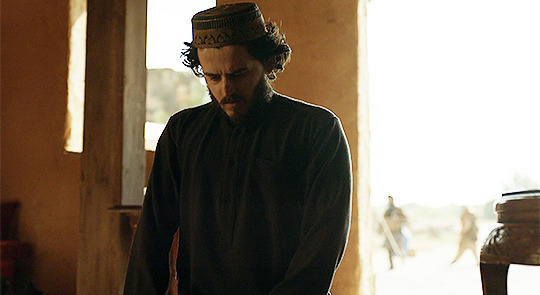
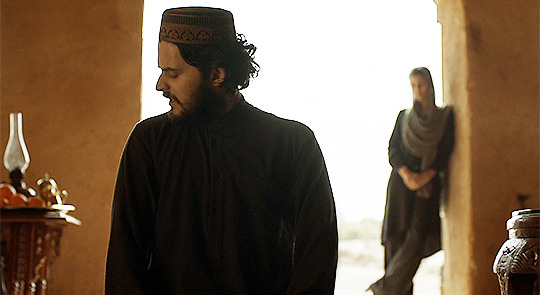

The slow pan around Jalal while he’s praying to reveal Tasneem is … *chef’s kiss* (and suggests so much her persona of being the ultimate puppet master, waiting around any corner).

More bokeh, more smoking. Smokehing.
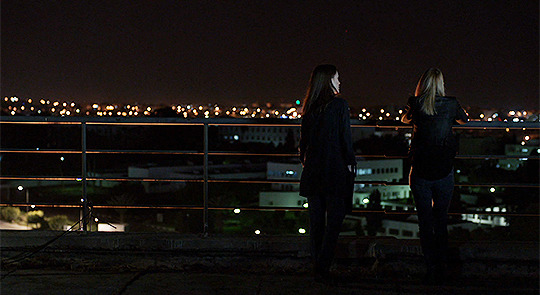
There’s more mirroring between Carrie and Jenna this week, which is probably how Jenna intends to befriend Carrie (“Carrie smokes? I should too!”), but it actually just feeds into Sara’s theory that Jenna is going to “single white female” Carrie. We love the framing here of Carrie, back to camera (and to Jenna), and Jenna lurking behind her.
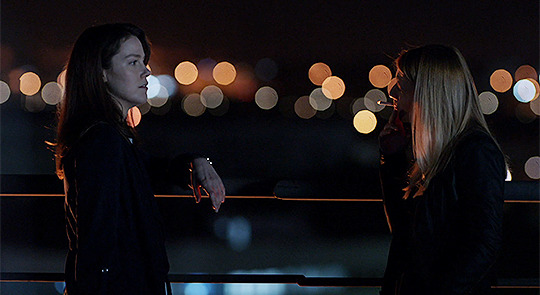
And some visual symmetry here. The camera shots of the two of them are often at a distance, speaking to the depth (or lack thereof) of their relationship. Throughout this episode we see a variety of different pairings between characters. The camera choices in these scenes illustrate closeness and proximity, or distance and mistrust.
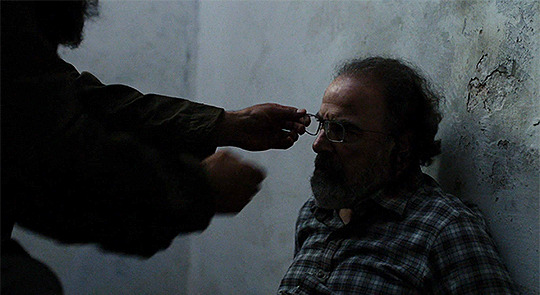
In season four there were so many references to Saul losing his eyeglasses during the prisoner exchange. If you recall, he takes them off on the tarmac and Carrie picks them up after she convinces him to get up. Later, she returns his glasses to him just as their car is hit by an RPG. So, given that, two things:
Saul losing his glasses and then getting them back is almost certainly a harbinger of shit to come!
We absolutely loved the framing of this scene: Haqqani’s hands slowly coming into frame and gingerly placing the glasses back on Saul’s face. We mentioned above how different the mood was this time around with Saul and Haqqani and this gentle act seemed to encompass all of that.
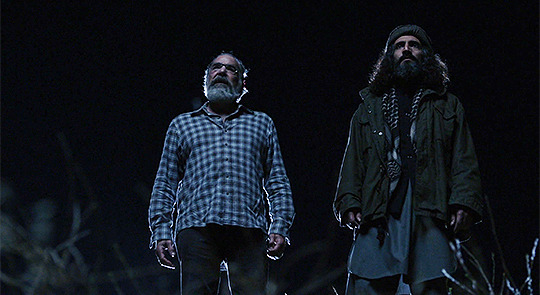
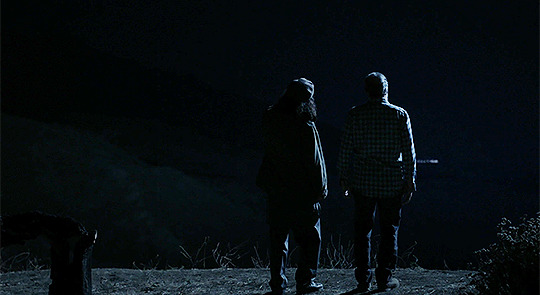
Two old men, some (we, Jalal) would say past their prime, standing alone in the dark.

And the dark gives way to a new dawn, a new day. We’re about to break out into song!
But seriously, this was a gorgeously filmed scene. We do wonder how long they were waiting out in the mountains of Morocco for the sun to rise.
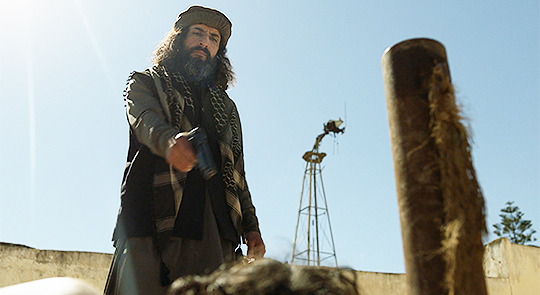
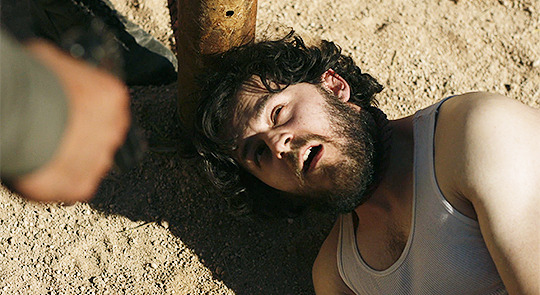
The scene between Haqqani and his son Jalal was the standout of the episode. It is such an eerie reflection of the end of “From A to B and Back Again” when Haqqani kills Aayan. That episode and its ending are at this point Homeland lore, which has the added benefit of making what was already a tense scene fucking unbearable.
We love the use of perspective and shot/reverse shot here.
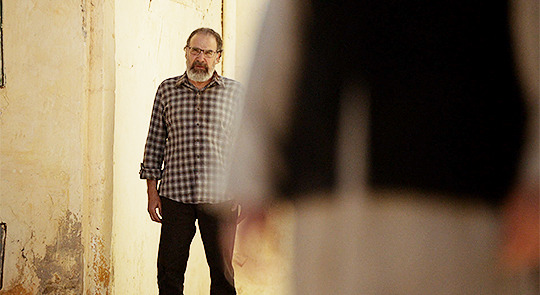
The parallels with “From A to B…” continue. Then as now, Saul looks on, helpless, wearing a similar outfit but this time with his hands unbound. Then as now, Haqqani makes a spectacle of it all, when he knows others are watching (the Americans via drone in season four, his entire crew in the courtyard now).
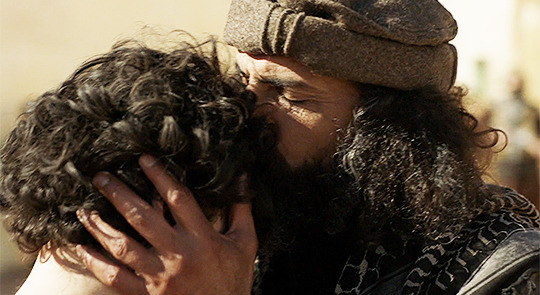
The kiss to the forehead. At this point we were about 650% sure Haqqani was about to shoot his son in the head.

And he does pull out the gun. Jalal literally stares down the barrel.
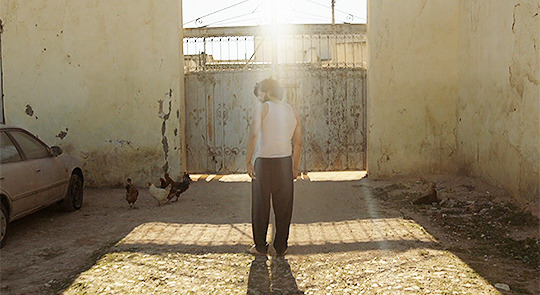
Instead of killing him, Haqqani just throws him onto the street, which is maybe just as bad if you’re Jalal. The framing here is remarkable. Jalal stands in the center of the frame, back to the camera, ensconced in sunlight. He’s not awash in some heavenly light. On the contrary, it’s almost as if he’s just been spit out of it, cast out of the kingdom. It all seemed vaguely biblical, like a reverse Prodigal Son, though we’re not sure if that fits exactly. If you know, drop us a line!

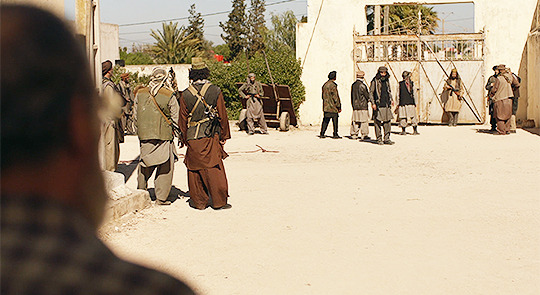
We’re three episodes into the season, and we’ve gotten an “over Saul’s shoulder” shot in each one. This is now a theme!
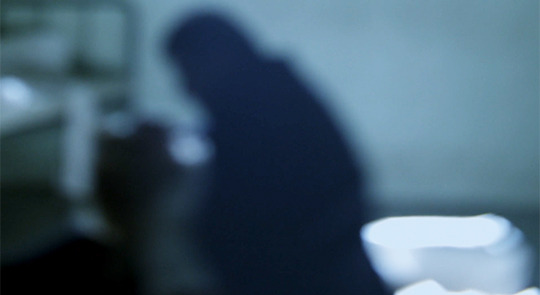
Homeland is not a show that uses flashbacks that heavily (other than the aforementioned Brody/Nazir series from season one and when they de-aged Claire Danes by putting her hair in a half ponytail). They’ve been effective thus far, slowly peeling the layer on the onion that is Carrie’s Russian captivity.
As Yevgeny recounts Carrie’s suicide attempt, we see split-second flashes in her head. At first, the images are blurry.
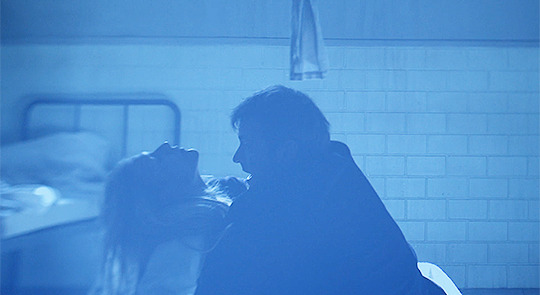
And just a few seconds later, they come into focus for us as Carrie remembers. All this is obvious enough, but we also think the way that the focus on the images shifts so suddenly and the way the sequences are edited serve to disorient the viewer in the same way Carrie remains disoriented and confused about just what happened during the seven lost months.


This scene is notable for a few reasons. First, Carrie and Yevgeny remain so physically close. He leans into her. We also love that it’s more than just Carrie’s reaction to what he’s saying. We see Yevgeny’s reaction to her reaction, as well as his emotions in recounting it. He is remarkably free of judgment and shows legitimate, deep caring, possibly love, as he reveals one of Carrie’s darkest moments.
And while Carrie makes an offhand remark about her relationship with Brody being accessible information in her “file,” the fact is she never talks about him. Like, ever. (Sara maintains Carrie has a mental and possibly physical “Brody box” that remains sealed.) The significance of Carrie opening up to Yevgeny about what is--sorry, folks--the love of her life really can’t be overstated.
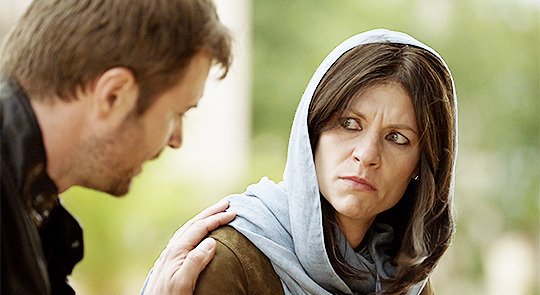
All we have to say about this is “ughhhhhhhhhh.”
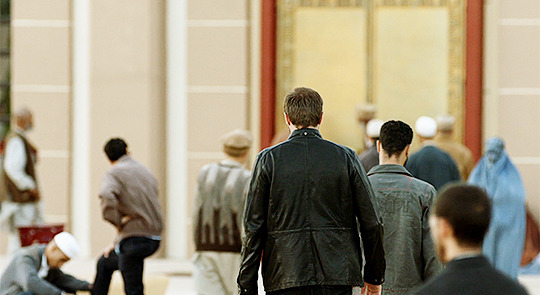
We’re three episodes into the season, and we’ve gotten a “Carrie watches Yevgeny walk away” shot in each one. This is now a theme!
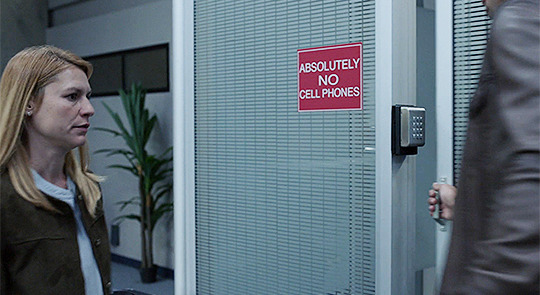
We really hope that the blaring red “ABSOLUTELY NO CELL PHONES” sign is a callback to when Brody infamously and inexplicably snuck his cell phone into the situation room in “Beirut Is Back,” allowing him to send a “DANGER! DANGER! DANGER!” text to Nazir just in the nick of time.

IJLTP.
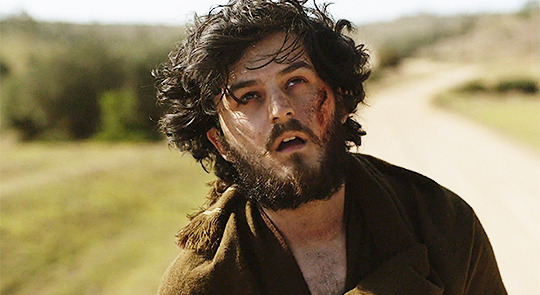
Here is our Reverse Prodigal Son: lost and wondering, his face bloodied, bordering on delirious.
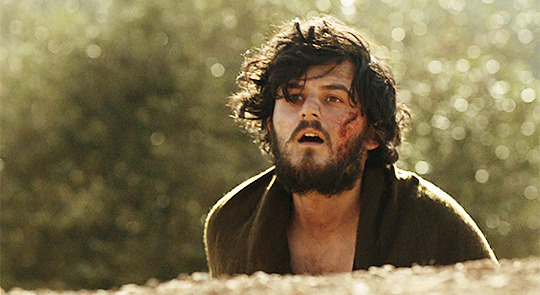

And here is Tasneem, her beautiful aubergine scarf blowing perfectly in the wind (sorry, Sara forgot to do Things Tasneem Wore This Week, but she thinks this aubergine scarf is beautiful), looking like a goddamn puppet master goddess, coming to save him. And by “save” we mean “control and manipulate.” Saviors really do come in all different flavors on this show.
#homeland#homelandedit#in the director's chair#keith gordon#peter levy#false friends#*#by: sara#by: gail
7 notes
·
View notes
Text
Honoring a Literary God: Neil Gaiman
Neil Gaiman is a writing genius. Recently, he’s been gaining lots of well-deserved recognition. With a new book released last month (Norse Mythology), a TV adaptation premiering in April (American Gods), and another book-to-TV adaptation recently announced (Good Omens), Mr. Gaiman has been pretty busy. I think it’s time we celebrate one of my favorite creatives; a prolific writer of books, comics, and screenplays.
I was first introduced to Neil Gaiman through his award-winning book, American Gods. I was immediately hooked, reading it more times than I can count (including now, in anticipation of the TV adaptation’s upcoming premiere). With its revolutionary re-imagining of old and new legends, there’s no surprise that it’s been looked at for TV/movie adaptations for some time. Excitingly, it’s finally set to air on the Starz network, starting April 30th. It is definitely one of my all-time favorite books and my recommendation to new Gaiman readers. American Gods was also a gateway book for me. Gaiman’s wonderfully imaginative way of looking at the world let me devour his body of work—Good Omens (written with Terry Pratchett), Neverwhere, Stardust, and more.
And he doesn’t just write adult books. Gaiman’s children’s book lineup is worth reading, no matter your age. From Blueberry Girl, which my little girl absolutely loves, to the gothic Coraline, Neil Gaiman has written for a wide range of ages. They are great entry points for younger readers to his widely imaginative, gothic fantasy world. Plus, many feature wonderful illustrations from artists like Gris Grime, Dave Mc Kean, and Skottie Young.
Neil Gaiman also has made a significant contribution to the comic book world. He began collaboration with DC by writing a short run comic, Black Orchid. This eventually led to his ground-breaking reinventions of DC’s Sandman. Dream, Death, and his vision of Lucifer became iconic, due to his blend of humor and fantastic horror. Gaiman’s Lucifer was a bit character in Sandman, but was so well-developed and loved that he was continued on in his own comic book series which was eventually adapted for TV. The success of Sandman lead to Gaiman working on other iconic titles like Swamp Things, Book of Magic initial mini-series, and two stories for the Secret Origins series—Poison Ivy and The Riddler. He even wrote a 2-part Batman story.
Of course, Gaiman’s talent hasn’t just been applied to literature, he’s written quite a few screenplays as well. A few also have become hit books for him, including Neverwhere, which was originally written as a BBC Series. The series and the book were released simultaneously, but contain some differences. Then there is my favorite children’s book/movie adaptation, MirrorMask. Gaiman wrote the story in collaboration with artist Dave McKean for Jim Henson Studios. If you have a chance to watch/read it, do it.
Then there are his random contributions to TV or movies. One notable adaptation was Gaiman’s work on the English script for Miyazaki’s Princess Mononoke, which just makes me love the movie even more. He has also written two Doctor Who episodes, “The Doctor’s Wife” and “Nightmare in Silver,” both highly-acclaimed episodes. He has also been involved in adapting his books into films, including Stardust, with Michelle Pfeifer and Claire Danes, and Coraline, a stop-motion animated film with Dakota Fanning and Teri Hatcher. Gaiman has also been highly involved in the current American Gods adaptation, including a recent trip to Iceland to record background video for the series. [He is also slated to be the showrunner for the Good Omens series for Amazon Studios. -Ed.]
When I think about the huge body of work listed above, I am humbled and awed. Genius should always be celebrated, and the large numbers of good things happening for Mr. Gaiman are warranted. Also, if you ever get the chance to hear him speak—don’t think, don’t question, just DO it. He was the most interesting speaker I ever had the pleasure to listen to. Allow me to finish on a favorite quote, one to live your life by: “Go and make interesting mistakes, make amazing mistakes, make glorious and fantastic mistakes. Break Rules. Leave the world more interesting for your being here.” Of course picking up one or all of Neil Gaiman’s books would not be one of these mistakes. Happy reading!
2 notes
·
View notes
Photo

“Catch and Release” | Directed by Lesli Linka Glatter, Cinematography by David Klein


A lot of Homeland, especially in the last few seasons with its focus on American politics, is about power: who has it, who wants it, and who can take it away. In many scenes, we can interpret the power balance based on how characters are filmed or placed relative to each other (for example, President Keane was often shot from below, as if she was towering over us).
Likewise, the show devoted a lot of exposition to the fact that Carrie and G’ulom had a good working relationship based on similar goals back when she was the Kabul station chief. We can see the visual evidence of it here. They sit opposite each other, on equal ground. They’re even in similar positions, leaning forward, elbows on knees. The framing here is actually ironic given that, as Carrie says later, G’ulom basically laughs her out of his office. But given what transpires between them later, we think the visual cues this framing offers are intended more to establish the dynamic of this relationship for the remainder of the season.

The production of season eight was split between Morocco and Los Angeles. The scenes of Max and his Marine buddies were all shot in LA. The filter here--sort of blueish grey--is incredibly distracting and very odd. The lighting on Max here is also interesting: he’s half in the light, half in the dark.

That said, we can get past it for this scene alone, where, one by one, each of the soldiers pat him on the head (for luck, seemingly) and call him “Maxie.”

We have another shot from behind Saul’s shoulder, the background out of focus. Again, we’re not sure what this means yet. It could be a visual motif Lesli Linka Glatter chose to string throughout her first two episodes of the season, or it could be something more symbolic, as we suggested last week: Saul is aging, out of touch, relegated to a role as observer. In the past he’s had a bigger plan at play, sometimes one that neither the audience nor Carrie was aware of. Now, he seems to be losing at his own game. By the end of the episode, his glasses are gone and his Plan A may be as well.

This scene and the slow procession of prisoners from out of the airplane is eerily reminiscent of the prisoner exchange in season four, down to all wearing the exact same color and cut of orange jumpsuit.
This time, of course, the exchange goes exactly to plan. The choice to conduct the exchange under cover of darkness, while Tasneem remains figuratively in the dark as well (temporarily at least), suggests Saul and Co. have learned from past mistakes.

Sara loves Carrie’s scenes with Jenna for all the reasons we’ve already stated, but in particular for this moment. Whatever this facial expression is, it feels strangely new. After seven seasons, it feels like we’ve seen every range and type of emotion Carrie has. But this! This actually does look like something we’ve never seen before, and it’s exciting to see Claire render that. As for what the emotion is, we’re going for “I don’t trust you but I’m trying to decide how much to let on that I don’t trust you.”

IJLTP.
Gail has actual analysis: Tasneem was shot at a similar distance in the last episode while smoking, and it’s interesting to see that same shot applied here to Samira. Samira is looking down, somehow somber. Meanwhile Tasneem was calm (wearing blue), calculating, and looking powerfully into medium distance. Both women hold an incredible amount of power: one who weaponizes it and one who is trying to learn how.

The color palette of Jenna’s and Samira’s outfits here is identical, which seems very intentional. What that means, we’re not sure, but it does look like Samira may be in a few more episodes this season, so we’ll see how/if thekr relationship evolves.
We need to note as well that Jenna is dressed almost exactly like Carrie was the day before, but with a red top instead of blue. Is Jenna mirroring Carrie or is this just the female CIA officer’s default uniform? (Your guess is as good as ours.)


The shot of Carrie from outside the car window comes earlier in the episode but we chose to feature it by a nearly identical one of Saul here. Last week we discussed how a similar image represented a trapped, cornered Carrie. This week, the purpose instead seems to be to draw a line between Carrie and Saul, mirrors of each other. Carrie is on the left beside Jenna, Saul on the right beside Haqqani’s cousin. Both are forced to work with people they don’t trust to complete a mission.
Saul actually steps into Carrie’s shoes by arranging the meeting with Haqqani, dangerously entering the field for what feels like the first time in many years. The contrast in their expression is notable, too. Saul looks hopefully upward. Carrie stares straight ahead, tense, focused, stewing in her initial failure with G’ulom.
The producers have talked at length about how the final season is about completing the story of Carrie and Saul’s relationship, so we anticipate more imagery in this vein as the season progresses.

IJLTP.

Saul waiting alone on the rooftop in Peshawar reminded us heavily of the rooftop scenes in “Beirut Is Back.” Again, more Carrie mirroring.

Tasneem looks like a fuckin’ B O S S. Everything here is amazing. We have to stan.

This image of Saul waiting on the rooftop was particularly provocative. He waits and watches, surrounded by garbage and other discarded objects.

We actually didn’t notice this Max potato head at first. Give the props department an Emmy and put this in the Louvre.



We loved this sequence of the Peshawar street growing gradually quieter as Saul realized what was about to happen (Sean Callery’s score only adds to the eeriness). Some of the most iconic Homeland scenes are about dread and some looming, inevitable tragedy. In this case, the build-up is more excruciating than the moment where the shots are actually fired.

The shift in Carrie’s demeanor after she successfully leverages G’ulom is palpable. She’s stomping through the Kabul streets like she absolutely owns the place. This sequence gives us shades of The Drone Queen (the person and the episode) and even calls back to the beginning of the season four premiere, when she’s also flanked by two guards while walking through Kabul.

Costa Ronin is a tall man, but this shot from Carrie’s perspective shows Yevgeny looming large over her, nearly taking up the entire screen, all she sees.
On a less serious note, we will never stop wondering how Costa Ronin became so hot. We remain convinced that he is being framed as a romantic lead. This little smirky thing? What is this????

IJLTP.


Admittedly, this is a fantastic ending (Sara: “how could Saul getting hit in the face not be?”), and Saul’s disbelieving, relieved smile harkens back to his at the end of “The Choice.” Then, he was thanking God that Carrie was alive. Now, it’s the leader of the Taliban. Perspective is everything. But my, how the mighty have fallen.
#homeland#homelandedit#catch and release#in the director's chair#lesli linka glatter#*#by: sara#by: gail
2 notes
·
View notes
Photo

“Sock Puppets” | Directed by Dan Attias

We interrupt our regularly scheduled programming to join Inside the Actor’s Studio: HYH Edition, care of Sara’s undying love for Carrie Mathison.
The therapist scene is fairly uninteresting from a directorial perspective, therefore the small choices matter. On the surface it is a simple one-on-one dialogue scene in which both actors are seated and facing each other. Attias chooses a stark, grey background and black clothes for Carrie. This is not a warm, fuzzy therapist’s office! It’s meant to feel clinical. Notably, almost all the shots are from the therapist’s perspective so the small differences such as the length of the camera from Claire are certainly intentional. (An easy parallel is Carrie’s video to Franny in “Why Is This Night Different,” in which the shots were almost all direct and very close to Claire’s face.)
In this shot, Carrie is talking about Franny. Attias positions Carrie in the center of the frame in a medium shot. Carrie’s feelings, at this juncture anyway, are not in question. The shot is uncomplicated and balanced.


As Carrie starts to talk about the Brody the camera pulls in slowly. Attias uses a tighter shot with Carrie still at the center, indicating that the therapist was reading what we did: sincerity, grief, and intimacy.

While the difference is subtle, when Carrie talks about Quinn the shot is a little more distant and Claire is positioned to the left of the frame, off center. We see Carrie struggling to explain her inner conflict with saving Quinn when, in fact, he may not wish to be alive. The longer shot may represent the fact that Carrie is unresolved and conflicted.

This is a familiar expression to any Homeland fan. In this shot the therapist is equating her struggles with “what every parent goes through,” and Carrie is clearly doubting whether the therapist can have any possible idea of how extraordinary her life circumstances are. There is a certain acknowledged guilt and even sad humor here.

Finally, after the therapist tells Carrie that sometimes four-year-olds need to come first, Carrie appears surprised. There is a combination of defensiveness and intense realization of his words on the heels of discussing her inner conflict regarding Quinn.

Homeland rarely does fades like this. The last words in the therapy session were “a four-year-old … needs, at times, to come first,” and the screen then fades to a dual shot of Carrie looking down and the back of Dar’s head as he walks into Keane’s office. Carrie appears to be “the light’ in the shot versus Dar’s darkness. What does this mean? You choose. Notably, Carrie was just speaking about Quinn. One possible interpretation is that Carrie and Dar are good versus evil vis-a-vis both Quinn and Keane. Alternately, it could foreshadow Dar’s ultimate victory — he is entering the president’s office, after all — while Carrie will choose Franny.
The last fade we can recall on Homeland was in “The Star.” The screen fades from Carrie watching Saul leave the CIA (having been pushed out by Lockhart) and Carrie walking back into the CIA into a darkened lobby in which she draws Brody’s star on the wall.
It may be a stretch, but if the fade in “Sock Puppets” may be meant to parallel the fade in “The Star,” it is worth noting that Brody’s shadow as the tragic love interest looms large. Carrie was drawing direct parallels to both loves in the scene.

In the first meeting with Dar, Keane and Dar are in sync. She seems to be coming around to Dar’s world view. Interestingly, the actors are about the same height yet Attias chooses to make Keane look much taller than Dar here. She is in control.

We come back to Carrie again after a lead-in from Dar. This time, his last words in the previous scene are “unfortunately, I couldn’t convince anyone they were wrong.” Here, Carrie is gazing at baby pictures of Franny in the midst of desperately trying to convince CPS they are wrong.

We just like this shot because it’s a shockingly accurate depiction of how we all react when we think someone has butt (or pocket!) dialed us.

When Carrie realizes it’s Javadi on the line and calls Saul, she immediately leaves Franny’s room. This is normal--people often do leave rooms for an important conversation--but it also conveys that Carrie’s CIA reality cannot co-exist with her life as a mother.

In the first shot featuring Quinn, Attias chooses a long shot in which we see everyone’s positions, including the police at the door. It’s been speculated that this is important because Quinn would not leave Astrid until he knew she would be properly cared for. Interestingly and tragically, Astrid is in the same position on the sofa as in “Imminent Risk” when she and Quinn reclined in front of the fireplace.


Much has already been discussed about the blood smear. Is Astrid’s blood warpaint as Quinn pivots to revenge? Is it about Astrid’s blood protecting Quinn as his did with Carrie in “Why is This Night Different”? What is clear is that Attias chooses to make this scene highly personal. Quinn uses two fingers to touch her heart and then smears her blood on his lips — both very intimate areas of the body. It is, in fact, a lover’s last goodbye.

The next shots of Quinn fleeing the cabin create a fantastic action sequence, enhanced by the dramatic score and use of handheld camera. Here the camera is erratic and Quinn is shot from behind, as if being pursued.


Once Quinn gets in the car though (and the score really amps up), Quinn wears a steely gaze and the camera finally stills. In fact, for all the shots of Quinn beginning here, the camera is far steadier than it’s been on Quinn for much of the last two episodes. We all understand this. Quinn is “coming home” to his old self. He is focused, angry and mission-driven. (We can hear the distant cheering fandom-wide.)

Homeland rarely uses symmetrical shots like this. Here, Keane is flanked on either side by Carrie and Saul, foreshadowing that she may come between them.

The establishing shot of Onyx caught our eye for two reasons. First, the flag is shown waving in reverse (typically we see shots of American flags with the stars on the left, rather than the right). And then there’s plane flying overhead. We’re not sure that either of these are coincidental.


As noted in prior Director’s Chair features, these type of half-faced conversations filmed from behind are almost always communicating half-truths and deception. The men’s wardrobes here are also significant (and we rarely say this about wardrobe on Homeland!), highlighted starkly against the wide surroundings of Onyx’s interior. Max is dressed in a crisp, patriotic navy. O’Keefe, meanwhile, wears a muddy orange-brown sweater. And yet the colors here don’t clash; they’re strangely complementary.

This sign was clearly designed by the Homeland crew (it’s far too clean and crisp to be a real sign). This is likely a reference to the 1994 Assault Weapons Ban. The law has a long list of exemptions lobbied for by the NRA, including allowing assault weapons manufactured prior to 1994 to be sold at gun stores like this one.

Cue Quinn’s unflinching walk! Apparently the trick for doubling down on a character’s badassery is to make sure he never looks back or reacts to the chaos he has just unleashed.

It’s hard not to think of the American flag with the red stripes on the wall Max stands in front of. This is likely to visually convey that Max is the only true patriot in O’Keefe’s nefarious propaganda machine.

We found this scene significant because it’s so similar to their first scene ever, way back in the pilot. Again, Carrie tries to convince Saul of an operation that could leave him in the crosshairs. Again, he refuses. Carrie and Saul hardly make eye contact in this scene and the weight of their conflict over the past five years sits heavy between them.

This is apropos of nothing except doesn’t Claire look great here? We love the matching blue hat and scarf.



Some of the most interesting shots of the episode were again at Onyx in what we’re dubbing the propaganda war room. As Max solves their technological issues, the crowd of pasty Millennial and Gen Y nerds cheer as the camera quickly pans in one direction and then pivots, as thousands of fake identities are revealed. The camera finally rests on Max, his eyes obscured by the reflection of these trolls in his glasses. The room itself brings to mind the ops rooms of past seasons, yet this time the mission isn’t dropping drones or depositing spies into Tehran. It’s a war over information, both real and fake. Consider the battle lines drawn.

Dar’s home, majestic by New York standards, is notable for the columns that stand guard on either side of the gate. The spirally coiled tops are called volutes. The column’s origins are, apparently, the Temple of Artemis. (If any architecture experts want to ring in here, please do!) We’re just going with the fact that Dar represents power, authority, and the establishment, and his home is a physical manifestation of that.

The final scene between Quinn and Dar evokes pain and abuse on almost every level. Dar, possibly Quinn’s abuser, is responsible for the bruises on his face, as well as for Astrid’s blood which remains smeared across Quinn’s lip. And then there’s the pain and abuse that doesn’t sit at the surface. In this shot Quinn’s psychological turmoil, also Dar’s doing, has never been clearer…. Literally fuck that guy!
38 notes
·
View notes